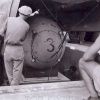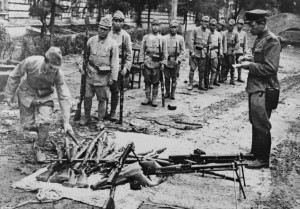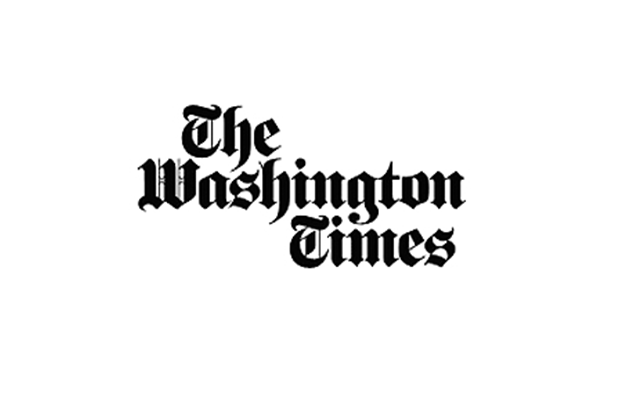
Seventy years ago, the atomic bombs known as Little Boy and Fat Man were dropped on Hiroshima and Nagasaki. In Hiroshima about 90,000 people were killed immediately; another 40,000 were injured, many of whom died in protracted agony from radiation sickness. Three days later, a second atomic strike on the city of Nagasaki killed some 37,000 people and injured another 43,000. Together the two bombs eventually killed an estimated 200,000 Japanese civilians. Was there really a need to create this nightmare? Did this nuclear onslaught really oblige Japan to surrender? This is too touchy a subject for public discussion in the US, which gives the rest of the world the right to ask Washington some uncomfortable questions.

Japanese soldiers surrendering their weapons to Soviet Army, northeastern China, Aug 1945. Source: US LIbrary of Congress
Q1
The United States dropped two nuclear bombs on Japan, a third, according to Brigadier General Leslie Groves, the director of the Manhattan Project, could have been ready for delivery by August 17 or 18, and a fourth by September 1945. But the American military command never canceled its training exercises for Operation Downfall – the ground invasion of the Japanese islands. How many Japanese cities would have eventually been incinerated by the Americans if, over the course of 12 days (Aug. 9-20, 1945) in Manchuria, the Soviet Union had not wiped out the Kwantung Army, the biggest command within the Japanese army, with over one million troops, and thus forced the surrender of Emperor Hirohito?
Q2
By August 1945, the US Air Force had been terrorizing Japanese cities using conventional bombs for several months. The aftermath of that was as calamitous as the fate of Dresden and Hamburg.
Little already remained of Tokyo long before the attacks on Hiroshima and Nagasaki. If the intent was to destroy tactical targets (and Hiroshima was one of the largest military centers provisioning the Japanese army and navy), would it not have been better to have gone about it using conventional weapons? The fact that Nagasaki was targeted almost at random (the plane originally flew to Kokura, but because of cloud cover it was unable to release its payload and turned toward Nagasaki instead), proves that the nuclear bombing of Japan was simply committed in order to terrorize the country. Originally the chosen targets for the attack were Niigata (a military base and industrial center), Yokohama (an industrial center), Kokura (which held the largest arsenal and warehouse), and Kyoto (also an industrial center). Kyoto was eliminated from the "list of death” because of its historical value thanks to some American generals who used to attend it before the war.
Q3
It took Emperor Hirohito and his war cabinet a long time to obtain a reliable assessment of the scale of the incident and to make a political decision based on the aftermath of the first bombing. Tokyo only learned about the use of these previously unknown weapons of mass destruction thanks to American radio broadcasts. The emperor was far more concerned about the attitude of Soviet Union regarding the war in the Far East. The emperor was ready to surrender back in May 1945, but not unconditionally like Germans. He wanted an honorable surrender that would safeguard his regime (what subsequently happened) and army. His trump card in the political bartering was the existence of the still viable Kwantung Army. This, and not the mythical "hundreds of thousands of kamikaze pilots,” posed the biggest threat to the Allies. If the Kwantung Army had not suffered a crushing defeat Japan could have held out a few more months. But the Allies would have found themselves embroiled in massive operations on mainland China, something for which the US was not ready.
…the entry of the Soviet Union into the war this morning puts us in a completely helpless position and makes continuation of the war impossible…
(Richard Hart, "Towards Decolonisation”, p.313)
Four days later, when the fate of the Kwantung command was almost a foregone conclusion, Emperor Hirohito decided to surrender. So what most affected his decision – the panicked reports from his military commanders in Manchuria or an American radio broadcast?
Q4
Neither President Truman, the US military, nor the rest of the world fundamentally grasped the consequences of the atomic bombardment. Of course, the scientists who created the bomb could theoretically imagine what its effect might be.
But the practical aspects behind the use of nuclear weapons, as well as the basic principles for how they were to be managed, developed only after seeing the impact of the bombing of Hiroshima and Nagasaki. Only then did an understanding evolve of the mechanism behind the spread of the shock-, light-, heat-, and electron waves, and only then did it become possible to forecast the damage by studying the landscape and weather. Effects of radiation were studied years later, based on observations of the "hibakusha” – the more than 200,000 people who were afflicted by the fallout. So is it possible that at that time the US was simply tempted to conduct an experiment on the civilian population of its wartime opponent, merely in order to make some adjustments to its scientific records?
Q5
There are no real reasons to believe that if the war had continued with the use of conventional weapons this would have resulted in the catastrophic level of casualties that were predicted by the US General Staff and President Truman.
RELATED VIDEO:








_jpg/250px-ElbeDay1945_(NARA_ww2-121).jpg)








